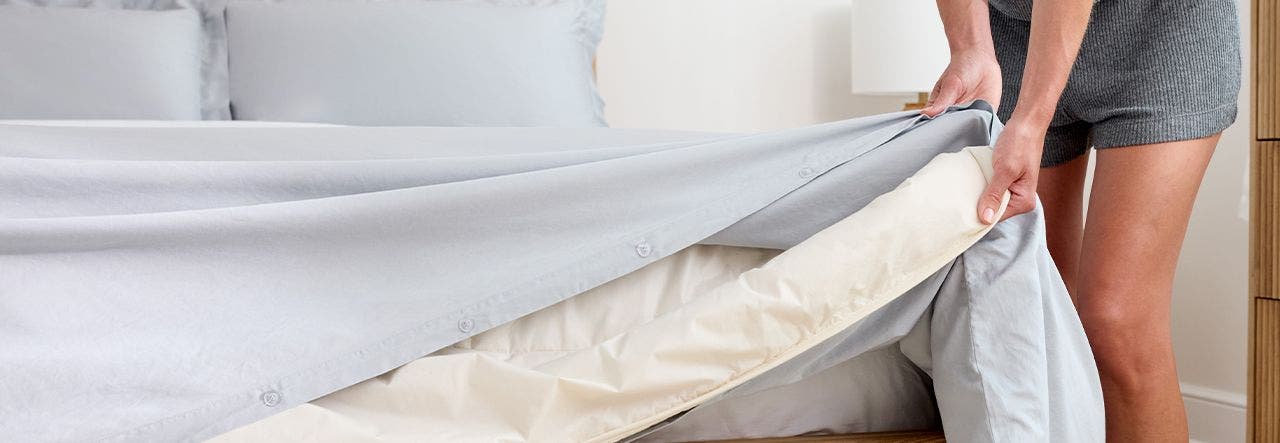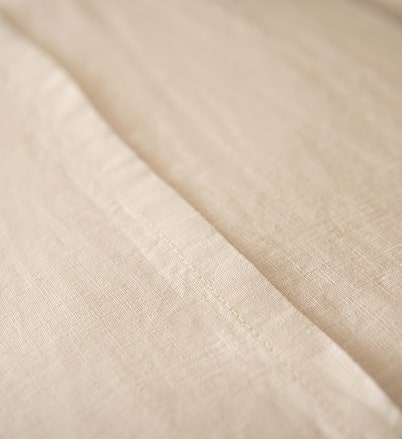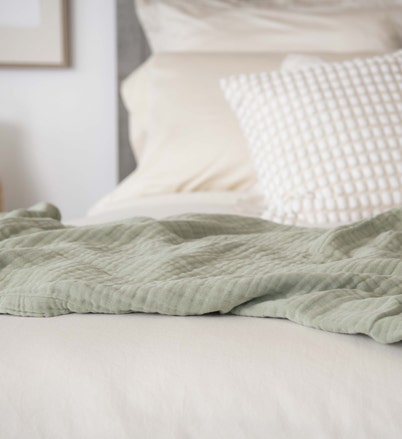A duvet cover is a protective and decorative fabric casing designed for a duvet or comforter. Much like a pillowcase for a pillow, a duvet cover safeguards your bedding from dirt, spills and general wear and tear, while also allowing for easy style updates. They’re a bedroom staple that provides both practical and aesthetic benefits.
For all those times you’ve wondered, “What is a duvet cover?” or “What are duvet covers made of?”, we’re here to provide the answers. From the materials they’re made of to their uses and maintenance tips, let’s dive into everything you need to know about the versatile bedding essential – the duvet cover.
The Basics: What Is a Duvet Cover?
A duvet cover is essentially a large fabric envelope that encases a duvet insert or comforter. Typically secured with buttons, snaps or zippers, the cover shields the duvet from everyday wear and tear. Duvet inserts and comforters themselves can be challenging to clean, often requiring professional laundering or careful at-home washing if your washer is large enough. A duvet cover is much easier to remove, wash and replace, making it a practical addition to any bedding setup.
Duvet covers also serve as a style statement. Available in a variety of fabrics, patterns and colors, they allow you to switch up the look of your bed without replacing the duvet insert or comforter itself. This versatility is why many decorators consider duvet covers an essential part of a well-dressed bed.
So what is a duvet cover’s purpose? Here are some key reasons to use one:
- To protect your duvet insert
- For easy maintenance
- For style versatility
- To regulate comfort
They can be a welcome (and cozy!) element to any bed. Plus, they come in neutral whites too if you prefer the simplicity of an insert on its own.
What Are Duvet Covers Made Of?
Duvet covers come in a variety of materials, each offering unique benefits. Naturepedic’s organic duvet cover fabrics include:


1. Cotton Percale
Cotton percale is known for its crisp, cool feel and matte finish. With a tight weave that ensures durability, this fabric is perfect for those who prefer a breathable, lightweight cover. Naturepedic’s organic cotton percale duvet covers are a great choice for warmer climates or hot sleepers who appreciate a fresh, airy texture.
2. Cotton Sateen
For a softer, silkier feel, Naturepedic’s cotton sateen duvet covers are ideal. Sateen’s specific weave creates a slight sheen and a luxuriously smooth surface. It’s a versatile fabric that strikes the perfect balance between breathability and coziness, making it a favorite for year-round use.
3. Cotton Muslin
Naturepedic’s cotton muslin duvet covers offer an ultra-lightweight, airy option with a relaxed, slightly textured finish. Muslin’s looser weave makes it incredibly breathable, ideal for layering or for those who prefer a more casual, laid-back aesthetic. It’s a great choice for summer bedding or a minimalist aesthetic.
4. Cotton Waffle
Textured and inviting, cotton waffle weave duvet covers from Naturepedic add an extra sensory dimension to your bed. This fabric’s signature grid-like texture enhances coziness while maintaining breathability. The organic cotton waffle weave combines durability with a touch of modern elegance, perfect for adding depth and dimension to your bedroom decor.
5. Flax Linen
Linen is a timeless favorite for its natural texture, durability and effortless style. Naturepedic’s linen duvet covers are crafted from organic flax fibers, making them sustainable and eco-friendly. Linen is prized for its breathability and ability to regulate temperature, keeping you cool in summer and warm in winter. Plus, it softens over time, making it more comfortable with each wash.
How to Choose the Perfect Duvet Cover
Selecting the right duvet cover for your bed involves considering a few factors, including your lifestyle, comfort preferences, style and the characteristics of your duvet insert itself. Here’s a few tips about what to keep in mind while shopping:


Size Matters
Duvet covers come in standard sizes: twin, full, queen and king. To prevent unnecessary frustration over a twin insert floating in a too-big cover, or a queen insert unable to fit into a too-small cover, you’ll want to match the size of the cover to your insert. Luckily, bedding sizes are pretty standard so if you have a queen duvet insert, then a queen duvet cover will work.
Closure Type
Duvet covers come in a wide variety of closure types. Zip closures provide a secure closure and are highly convenient with their quick ease of use. Button and snap closures offer a more classic look, or even extra style since the closure itself can offer its own design in addition to the look of the cover. You may also come across covers with tie closures, which can be complementary to certain aesthetics like shabby chic, romantic or cottage. Zip closures are great for efficiency – especially if you plan on washing or replacing the cover frequently. Whereas the button, snap and tie closures are more focused on style.
Material Preference
You’ll be sleeping with this cover all night, every night until you wash it or replace it, so it’s important to consider the feel and functionality of the fabric itself. Organic cotton is ideal for those seeking a soft, reliable material that doesn’t get too hot thanks to its natural moisture-wicking properties. Linen has a more textured, casual aesthetic thanks to the lived-in look it provides, and because of its breathability, it also doesn’t sleep hot. Cotton and linen often get better with age and the more you wash them, too. And they’re more sustainable bedding options!
Design and Color
The focal point of any bedroom is the bed, so while shopping, keep in mind that your duvet cover will be a standout feature in your room. Since it’s such a prominent component, you’ll want it to complement your existing bedroom decor and aesthetic – and it’s always better to avoid fleeting trends and fast fashion, even in the bedroom. Neutral tones and Earth tones in simple, classic designs create a timeless look and can go with pretty much anything.
How to Use a Duvet Cover


Using a duvet cover may seem tricky at first, but with a simple process, it can become second nature. The key is to think of the duvet cover as a protective envelope and the duvet insert as its filling. To start, turn the duvet cover inside out and lay it flat on your bed with the opening positioned at the foot. This might seem counterintuitive, but trust us – it’s an essential step.
Next, place your duvet insert on top of the inside-out cover. Make sure the edges and corners of the insert align neatly with those of the cover. If your duvet cover has interior ties, use them to secure the duvet insert in place. This step ensures the duvet stays evenly distributed inside the cover, preventing bunching or shifting.
Now comes the part that many find the most challenging: flipping the cover. Reach inside the duvet cover and grab the top corners of both the cover and the insert. Holding these corners firmly, flip the cover right side out, allowing the duvet insert to slide inside. Shake the entire setup gently to help the insert settle into place and fill out the cover fully.
Finally, close the duvet cover using the closure at the opening, smooth out the surface to remove any wrinkles or uneven areas and you’re done!
Caring for Your Duvet Cover
Regular care extends the life of your duvet cover and keeps your bedding looking its best. Here are some tips:
- Follow Care Instructions: Always check the label for washing and drying guidelines.
- Wash Regularly: Wash your duvet cover every one to two weeks to maintain cleanliness and freshness.
- Avoid Harsh Detergents: Use a gentle detergent, especially for natural fabrics like organic cotton or linen.
- Store Properly: When not in use, fold and store your duvet cover in a cool, dry place to prevent discoloration or mildew.
By maintaining your duvet cover, you’ll preserve its appearance and functionality for years to come. Want to learn more about Naturepedic’s duvet covers? Meet our organic bedding collection!
 BABY
BABY  KIDS
KIDS  ADULT
ADULT  LEARN
LEARN  STORES
STORES 


